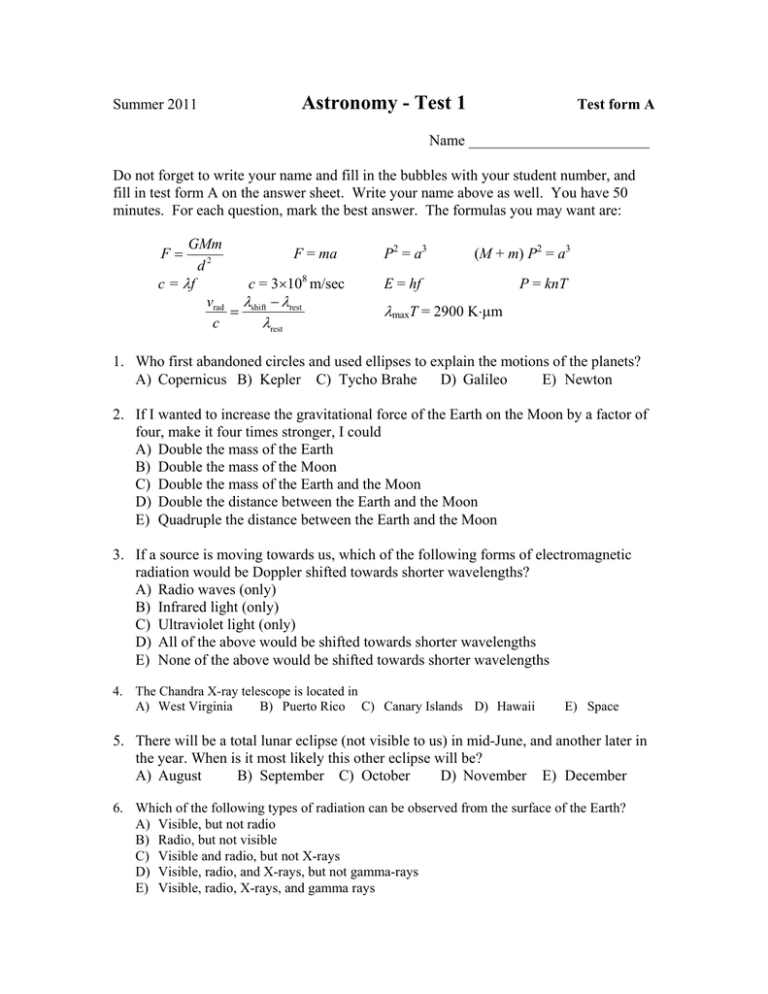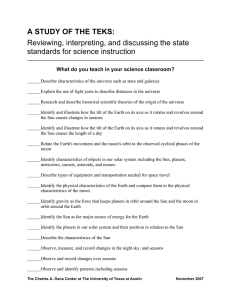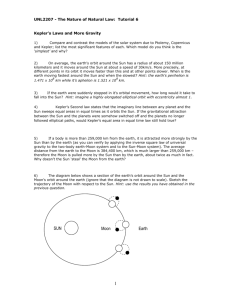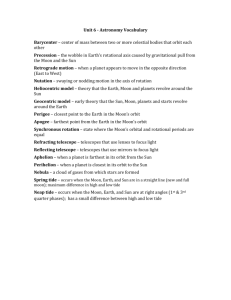Astronomy - Test 1
advertisement

Summer 2011 Astronomy - Test 1 Test form A Name ________________________ Do not forget to write your name and fill in the bubbles with your student number, and fill in test form A on the answer sheet. Write your name above as well. You have 50 minutes. For each question, mark the best answer. The formulas you may want are: GMm F = ma d2 c = f c = 3108 m/sec vrad shift rest c rest F P2 = a3 (M + m) P2 = a3 E = hf P = knT maxT = 2900 Km 1. Who first abandoned circles and used ellipses to explain the motions of the planets? A) Copernicus B) Kepler C) Tycho Brahe D) Galileo E) Newton 2. If I wanted to increase the gravitational force of the Earth on the Moon by a factor of four, make it four times stronger, I could A) Double the mass of the Earth B) Double the mass of the Moon C) Double the mass of the Earth and the Moon D) Double the distance between the Earth and the Moon E) Quadruple the distance between the Earth and the Moon 3. If a source is moving towards us, which of the following forms of electromagnetic radiation would be Doppler shifted towards shorter wavelengths? A) Radio waves (only) B) Infrared light (only) C) Ultraviolet light (only) D) All of the above would be shifted towards shorter wavelengths E) None of the above would be shifted towards shorter wavelengths 4. The Chandra X-ray telescope is located in A) West Virginia B) Puerto Rico C) Canary Islands D) Hawaii E) Space 5. There will be a total lunar eclipse (not visible to us) in mid-June, and another later in the year. When is it most likely this other eclipse will be? A) August B) September C) October D) November E) December 6. Which of the following types of radiation can be observed from the surface of the Earth? A) Visible, but not radio B) Radio, but not visible C) Visible and radio, but not X-rays D) Visible, radio, and X-rays, but not gamma-rays E) Visible, radio, X-rays, and gamma rays 7. The number of waves that pass a given point per second is called the wave’s A) Frequency B) Wavelength C) Intensity D) Period E) Velocity 8. Kepler said that planets sweep out equal areas in equal times as they orbit the Sun. How was this rule changed by Newton? A) He said this was true only for objects orbiting the Sun, but not other objects B) He said this was true only if you multiplied by the combined mass of the two objects C) He said it was equal angles, not equal areas D) He said the rule was just completely false E) He did not modify this rule at all; it was still correct 9. Which of the following pieces of information about the connections between the sky and the calendar is not correct? A) The year roughly corresponds to the cycle of how high the Sun is in the sky B) The month is roughly corresponds to the cycle of the phases of the Moon C) The week roughly corresponds to the cycle of how the planets move D) The day roughly corresponds to the cycle of when the Sun is up/not up E) Actually, all of the above are correct 10. An explorer traveling from the Earth to Mars in a rocket would experience weightlessness until A) Mars’s gravity exceeds the Sun’s B) Mars’s gravity exceeds the Earth’s C) The rocket enters Mars’s atmosphere D) The rocket touches Mars’s surface E) Some additional force, like the rockets motors, pushes on the rocket 11. Why does Kepler’s third law, P2 = a3, work so well, when Newton taught us the correct formula is (M + m) P2 = a3? A) For objects going around the Sun, M + m is so close to one (solar mass) that it gives almost exactly the right answer anyway B) The constants M and m refer to the fraction of the total mass in each object, and obviously the sum of all fractions is automatically one C) Since Kepler had no idea what the overall scale of the solar system was, he had no way of getting an overall factor, which could only be worked out with the help of Newton D) Since Kepler was observing everything from Earth, the mass was one, by definition E) Kepler was working with the highly flawed data of Tycho Brahe, whereas Newton had the much more accurate data from Copernicus to work with 12. If you drive your car for a while, the air temperature increases in the tire and the pressure increases. What causes the increased pressure? A) Hot electrons in the atoms have a stronger electric repulsion of the electrons in the wall B) Heat decreases density, which decreases the gravitational force of the gas, which allows it to expand more C) Light emitted by the hot atoms are absorbed by the tires, pushing them outwards D) Atoms are moving faster, and collide harder with the tires, pushing them out E) Chemical forces are pushing on the tires, and heat increases the rate of chemical reactions 13. As we will learn shortly, Saturn’s rings are made of countless tiny bits of ice. Why don’t all these bits gravitationally come together to make a big Moon of Saturn? A) Ice is too cold to have significant gravitational force B) The rings are inside the Roche limit, and tidal forces from the planet would tear them apart even if they came together C) The rings are held in place by electrical forces, which are more powerful than gravitational forces D) If they came together, they would act like a giant lens, focusing the Sun’s energy and then melting E) The pieces are so small that any gravitational force is just insignificant 14. Suppose a new asteroid is discovered, and it is found that its position is never more than 72 away from the Sun. What would this tell us about the asteroid? A) It must be orbiting the Earth, rather than the Sun B) It must orbit the Sun, but it tells us nothing about the distance from the Sun C) It must orbit the Sun, and its orbit must be closer than the Earth’s orbit D) It must orbit the Sun, and its orbit must be farther than the Earth’s orbit E) It must orbit the Sun, and its orbit must be very eccentric (not-circular) 15. What objects in the sky follow the ecliptic exactly? A) The Sun, but not the Moon nor the planets B) The Moon, but not the Sun nor the planets C) The Sun and the Moon, but not the planets D) The Sun and the planets, but not the Moon E) The Sun, Moon and planets 16. The Sun is highest in the sky around noon on the first day of A) Fall B) Winter C) Spring D) Summer E) Ramadan 17. Which of the following is explained by the Bohr model of the atom, but not the solar system model of the atom? A) The type of atom is determined by the charge of the nucleus B) The atom contains both a positively charged nucleus and negatively charged electrons C) The electrons orbit the nucleus D) The nucleus is much heavier than the electrons E) A given type of atom tends to emit or absorb only very specific frequencies 18. Why in radio astronomy is it advantageous to use several telescopes, sometimes hundreds or even thousands of kilometers apart? A) This allows us to see large celestial objects, hundreds or even thousands of kilometers across B) This allows one to get around the diffraction limit, allowing one to see smaller details of the target C) This allows one to compensate if there are clouds or interference at one site D) This spreads the money among several congressional districts, increasing the chance of getting funding E) This allows one to image different sides of distant astronomical targets 19. Which of the following was first discovered by Galileo? A) The planets sometimes move forwards and sometimes backwards compared to the stars B) There were undiscovered planets (Uranus and Neptune) C) The Moon is actually made of green cheese D) Jupiter has moons that go around it E) None of these were discovered by Galileo 20. There were multiple arguments for why the Earth was a sphere in ancient times (more than 2000 years ago), but probably the best one was that A) Ancient mariners found that when they traveled east or west, they had to adjust their clocks for the different time zones B) The cycle of tides on the Earth could only be explained assuming a spherical Earth C) Solar eclipses showed that a spherical Earth was blocking our view of the Sun D) Lunar eclipses showed that the Earth’s shadow on the Moon was always round E) Measurements of gravity from nearby points showed that “down” was not exactly parallel for different points on the Earth 21. According to modern astronomers, when we refer to a constellation like Sagittarius, we are referring to A) A direction in the sky as viewed from Earth, with well-defined boundaries B) A small group of stars that appear to form a pattern in the sky C) A one month period of time, when the Sun is in a certain direction D) A set of imaginary lines joining a certain set of stars in the sky E) Nothing; constellations are used in astrology, not astronomy 22. The object with the largest tidal effect on the Earth is the ______ , and the second largest is ______ . A) Moon, Sun B) Sun, Moon C) Jupiter, Moon D) Sun, Jupiter E) Jupiter, Sun 23. The fact that the Moon was actually a sphere, not a flat disk, was first figured out by A) Copernicus B) Tycho Brahe C) Galileo D) Newton E) None of the above; it was figured out in ancient times 24. Maritime radio location can operate at a frequency of 3.00 GHz (= 3.00 ×109 s-1). What would be the corresponding wavelength at this frequency? A) 10.0 m B) 1.00 m C) 0.100 m D) 9.00×1017 m E) 1.11×10-18 m 25. Two identical particles will electrically repel each other if their charge is A) Positive, but not negative B) Negative, but not positive C) Positive or negative, but not zero D) No matter what their charge is: positive, negative, or zero E) They will never repel each other 26. How does the Moon’s orbit around the Earth compare to the Earth’s orbit around the Sun? A) The Earth’s orbit is an ellipse, but the Moon’s is a parabola B) The Earth’s orbit is an ellipse, but the Moon’s is a hyperbola C) They are both in elliptical orbits, but the Moon’s orbit is tilted a bit (about 5) D) They are both in elliptical orbits, and the Moon’s orbit is in the same plane E) The questions if false, since the Moon orbits the Sun, not the Earth 27. If you went out at night and looked at a star with the naked eye, what property of the star would give you some idea of how hot that star is? A) Its brightness B) Its color C) How much it twinkles D) Its position in the sky E) It is impossible, by naked eye, to have any idea of the temperature of the star 28. The galaxies M31 and M33 are both about 2.3 million light years from us. M31 has an angular size of about 4 degrees. M33 has an angular size of about 62 arc-minutes. From this, we can deduce that A) M31 has the larger angular size, but we can’t tell which is actually larger B) M31 has the larger angular size and actually is larger C) M33 has the larger angular size, but we can’t tell which is actually larger D) M33 has the larger angular size and actually is larger E) We can’t deduce anything about the relative sizes or angular sizes from this information. 29. In adaptive optics, why do motors controlled by computers constantly adjust the shape of the mirror? A) They are compensating for vibrations caused by things that shake the telescope B) They are compensating for changes in shape of the mirror caused by small heating/cooling of the mirror C) They are compensating for the motion of celestial objects as they move D) They are compensating for the rotation of the Earth E) They are compensating for distortions caused by the atmosphere 30. The Earth orbits the Sun in a circle (approximately) because the Sun is pulling on it. Why doesn’t the Sun move in response to the gravitational pull of the Earth? A) Only the less massive object (the Earth) is affected by the gravity of the more massive object (the Sun) B) The Earth’s pull is exactly cancelled by the pull of all the other planets C) The Earth pulls on the Sun a lot less than the Sun pulls on the Earth, so the effect is barely noticeable D) Though the Earth and the Sun pull with the same force on each other, the Sun is more massive and therefore moves less E) The Sun and the Earth move approximately the same amount, but since we can only measure the relative position of the two objects, we don’t notice. 31. The colors of the visible spectrum, from shortest wavelength to longest, are A) red, orange, yellow, green, blue, violet B) violet, blue, green, yellow, orange, red C) orange, red, green, yellow, violet, blue D) blue, violet, yellow, green, red, orange E) vermillion, saffron, chartreuse, turquoise, indigo 32. Professor Carlson is doing a demo where he swings a massive ball around in a circle. Unfortunately, at the point shown, the string breaks suddenly, when there are students sitting at the points indicated. Which student is in the most danger? Ignore gravity or any other forces on the ball. D C Prof. Carlson B A E 33. To use the ideal gas law, P = knT, the temperature T must be measured in A) Kelvin (only) B) Fahrenheit (only) C) Centigrade (only)\ D) Kelvin or Centigrade will work, but not Fahrenheit E) Kelvin, Fahrenheit, and Centigrade all work





